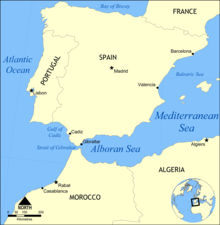Gulf of Cádiz
| Gulf of Cádiz | |
|---|---|
 | |
 Map showing the Gulf of Cádiz. | |
| Location | Atlantic Ocean |
| Coordinates | 36°50′N 7°10′W / 36.833°N 7.167°W |
| Basin countries | Spain |
| Average depth | 200 to 4,000 m (660 to 13,120 ft) |


The Gulf of Cádiz (
here.The Gulf of Cádiz is located in the north-eastern Atlantic Ocean between 34°N and 37°15′N and 6°W to 9°45′W.
Geology
The geological history of the Gulf of Cádiz is intimately related to
- subduction associated with the westward emplacement of the Gibraltar Arc and formation of the Gulf of Cádiz accretionary wedge.[3] The current activity of the subduction is unclear, with some advocating ongoing active subduction.[2] Others suggest that subduction is inactive and that a new plate boundary has recently formed along a series of prominent WNW–ESE trending lineaments acting as a dextral strike-slip (transform) plate boundary.[4]
- oblique lithosphere collision between

It is now well established that the whole area is under compressive deformation and that mud volcanism and processes associated with the escape of hydrocarbon-rich fluids sustain a broad diversity of chemosynthetic assemblages.[1] The accretionary wedge formed by subduction represents an extensive area which encompasses over forty mud volcanoes (a type of cold seep), at depths ranging from 200 to 4,000 m (660 to 13,120 ft) (confirmed by coring), and active methane seepage has been documented on several locations.[1][8]
Biota
The occurrence of chemosymbiotic biota in the extensive mud volcano fields of the Gulf of Cádiz was first reported in 2003.
See also
References
- ^ PMID 21976991.
- ^ .
- .
- .
- .
- .
- doi:10.1130/G33107.1.
- ^ .
